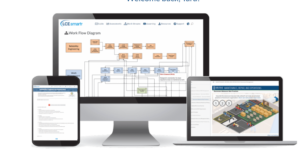The Situation:
USS Makin Island (LHD-8), a Wasp-class amphibious assault ship, is the first U.S. Navy surface ship to implement a 4160 VAC Zonal Electrical Distribution System (AC ZEDS) as well as incorporating 5000 HP electric propulsion motors that can be configured in an “integrated power system” (IPS) mode to take power from the electrical generation/distribution system. The LHD 8 concept for electrical power generation, distribution and electric propulsion represents the intent of the all-electric warship. The purpose of the electric drive system is to save fuel by acting as an alternative to the gas turbine engines during low-speed operations, where gas turbines are less fuel efficient.
The Challenges:
The LHD 8 machinery plant represents a significant departure from previous LHD class ships with a propulsion system that combines an LM2500+ and electric motor per shaft. The propulsion system integrates the first U.S. Navy application of this gas turbine engine with the ship service electric plant. This complex system affords many advantages to the ship designers with respect to reconfigurability, survivability and maneuvering. However, the design challenges the ability of the Machinery Control System (MCS) to maximize the effectiveness of this complex machinery plant. The MCS is a software-based distributed system utilizing a high-bandwidth network. The system relies on the VME platform for control processing, data acquisition and operator control.
The Approach:
Build 9 was a significant MCS and HMI software upgrade for the LHD-8. Many hours were spent in the LHD-8 Land-Based Test Facility (LBTF) developing and testing the software according to CMMI Level-3 standards. Once Build 9 was deemed ready for installation on the ship, pre-installation preparation took place. This included final testing of database backup and restore scripts, burning disk sets of the software install and testing all copies of the install disks in the LBTF, and finalizing a checklist of items and install documents to bring to the ship.
Once onboard the LHD-8, there was a two-week effort to install and test Build 9. In preparation for the install, all tactical and training database servers (DBS) and LAN switch configuration files were backed up. Then all Data Acquisition Units (DAUs) were powered off and the process of loading the software updates commenced. Build 9 software updates were installed to the LAN switches, On Board Trainer (OBT), DAUs, and Operation Station Units (OSUs). The Data Base System (DBS) was then installed, user accounts were restored and scripts were run to verify that all Build 9 updates were in the database. Upon completion, the appropriate crew received training on how to perform the installs.
The Results:
During the testing of the new MCS build on ship, several issues were identified which needed to be resolved. This included issues with the ventilation fan status on the MCS, Fuel Control System (FCS), LAN Switch alarms and Automated Bridge System (ABS). Many of the issues were resolved during ship testing; others required further testing back at the LBTF. Prior to leaving the ship, the ship’s database was backed up, as Build 9 was formally delivered to the ship.
Upon return to the LBTF, the ship’s database and Wireshark captures from the ship were reviewed. Alarm logs from the ship were analyzed. Estimates were made for incremental software changes and work was started on Build 10 items.
© 2014 Life Cycle Engineering, Inc.
For More Information
843.744.7110 | info@LCE.com
















